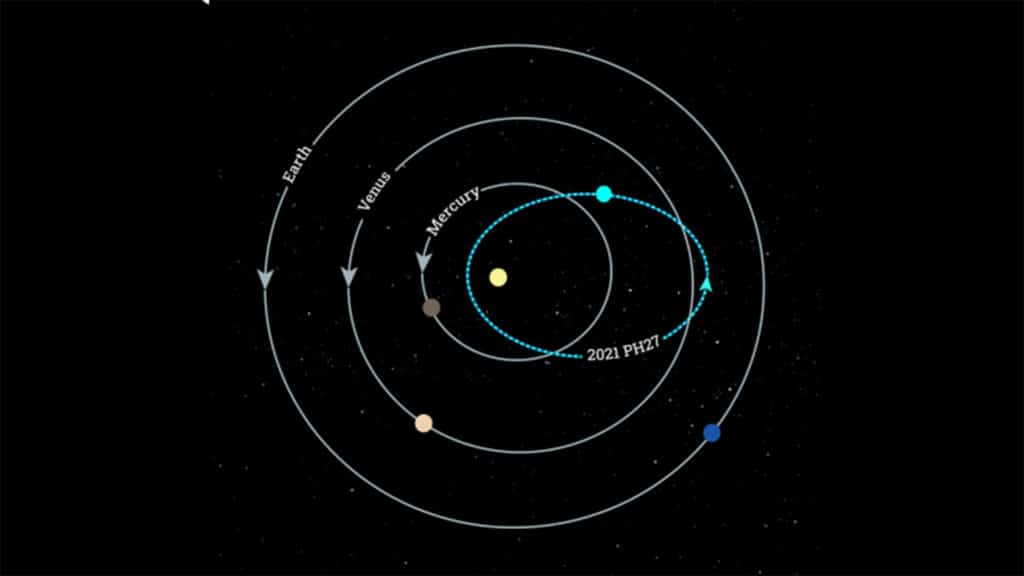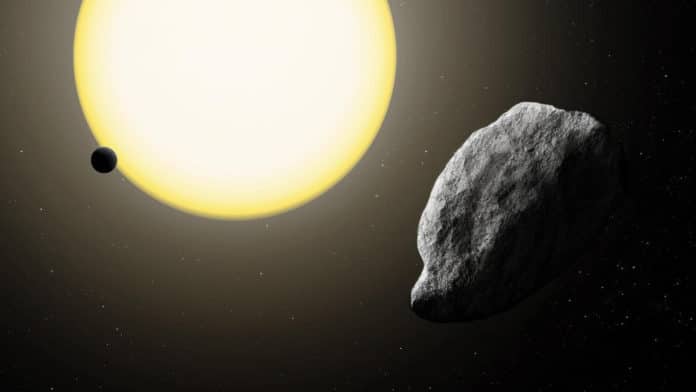Astronomers have discovered the fastest-orbiting asteroid that orbits the Sun in just 113 days. Known as 2021 PH27, the asteroid has the shortest known orbital period and the second shortest for any object in our Solar System after Mercury.
Discovered by Carnegie’s Scott S. Sheppard in evening twilight images taken by Brown University’s Ian Dell’Antonio and Shenming Fu, the asteroid is about 1 kilometer in size. It is found to be in an unstable orbit that crosses that of Mercury and Venus.
Studying such objects could help scientists understand the origin of asteroids and the forces that shaped our Solar System’s architecture.
Sheppard said, “Most likely 2021 PH27 was dislodged from the Main Asteroid Belt between Jupiter and Mars, and the gravity of the inner planets shaped its orbit into its current configuration. Although, based on its large angle of inclination of 32 degrees, it is possible that 2021 PH27 is an extinct comet from the outer Solar System that ventured too close to one of the planets as the path of its voyage brought it into proximity with the inner Solar System.”
The asteroid 2021 PH27 is so close to the Sun’s massive gravitational field. Because of this proximity, the asteroid experiences the largest General Relativistic effects of any known Solar System object. This is seen in a slight angular deviation in its elliptical orbit over time; a precession movement occurs at about one arcminute per century.
Sheppard said, “2021 PH27 gets so close to the Sun that its surface temperature gets to around 900 degrees Fahrenheit at closest approach, hot enough to melt lead.”
Future observations of this object will shed more light on its origins. Comparing 2021 PH27 to objects that orbit beyond Earth will improve scientists’ knowledge of its composition and the materials that enable its survival under these extreme conditions. An object like 2021 PH27 experiences tremendous thermal and internal stresses due to its proximity to the Sun.

The only efficient method for spotting asteroids that move around the Sun in orbits closer than Earth’s own is to take images as the Sun sets or rises, which Dell’Antonio and Fu did with the Dark Energy Camera on the National Science Foundation’s Blanco 4-meter telescope in Chile. Their main research is part of the Local Volume Complete Cluster Survey, which observes most of the massive galaxy clusters in the nearby universe with increased detail.
Dave Tholen of the University of Hawaii said, “Because the object was already in the Sun’s glare and moving more toward it, we needed to determine the object’s orbit before it was lost behind our central star. I surmised that for an asteroid this size to remain hidden for so long, it must have an orbit that keeps it so near to the Sun that it is difficult to detect from Earth’s position.”
Additional images were obtained the following night using the Magellan telescopes at Carnegie’s Las Campanas Observatory in Chile and again with NSF’s 4-meter Blanco telescope. The third night of follow-up observations was needed to determine the new asteroid’s orbit before it was lost. Still, cloudy weather in Chile elicited a trek around the world to South Africa thanks to the activation of the Las Cumbres Observatory’s extensive network of global 1-meter telescopes.
